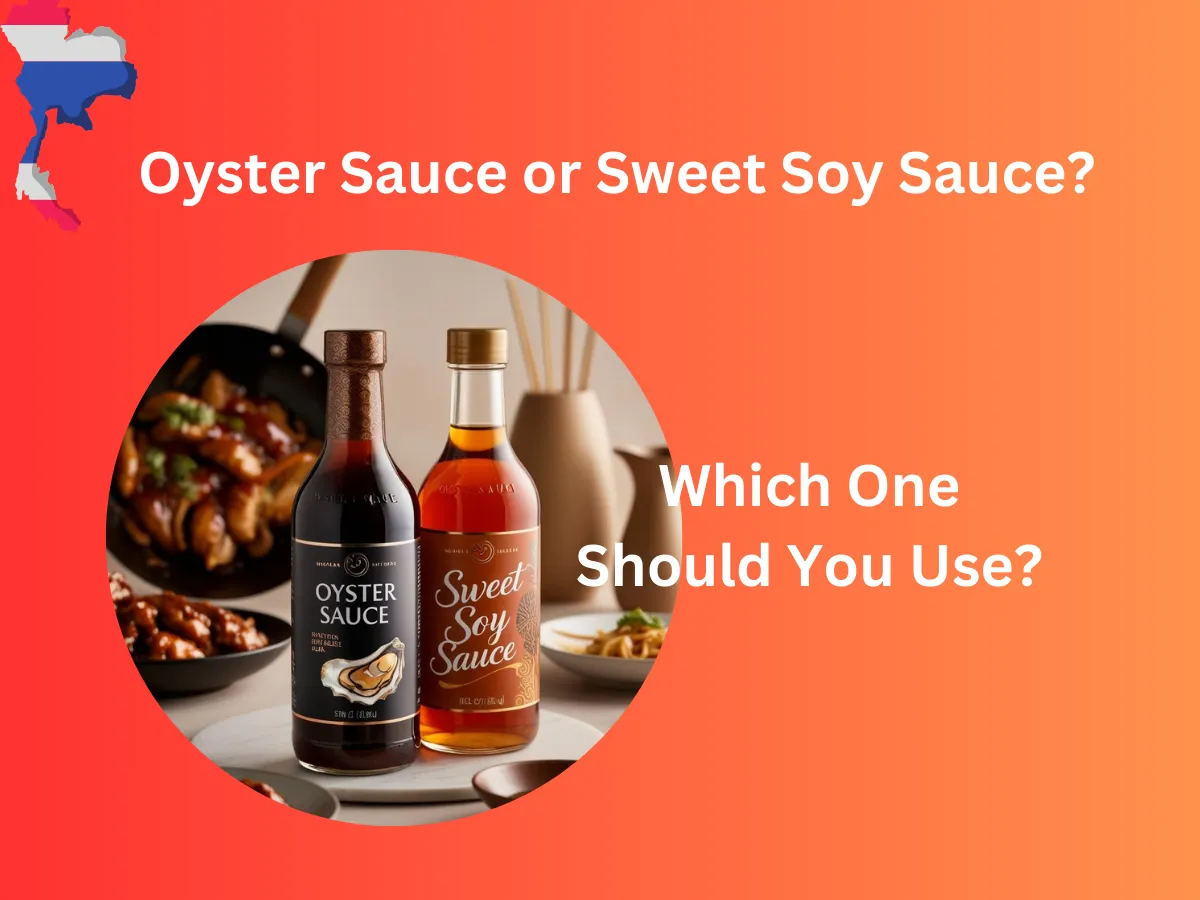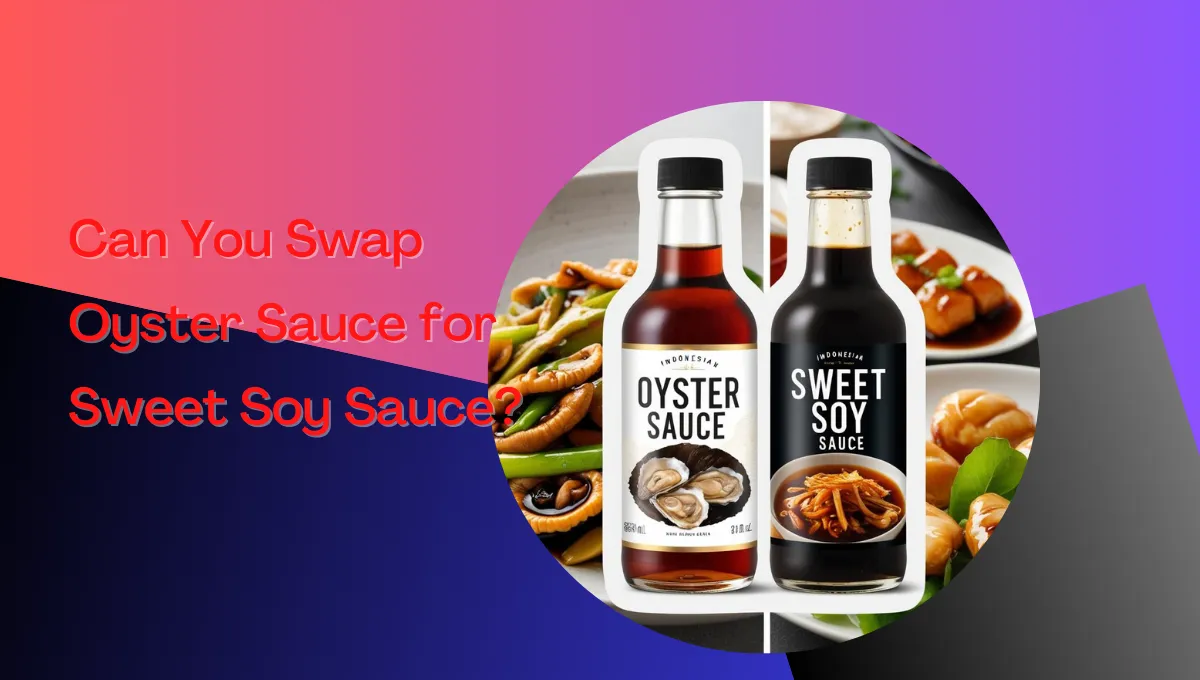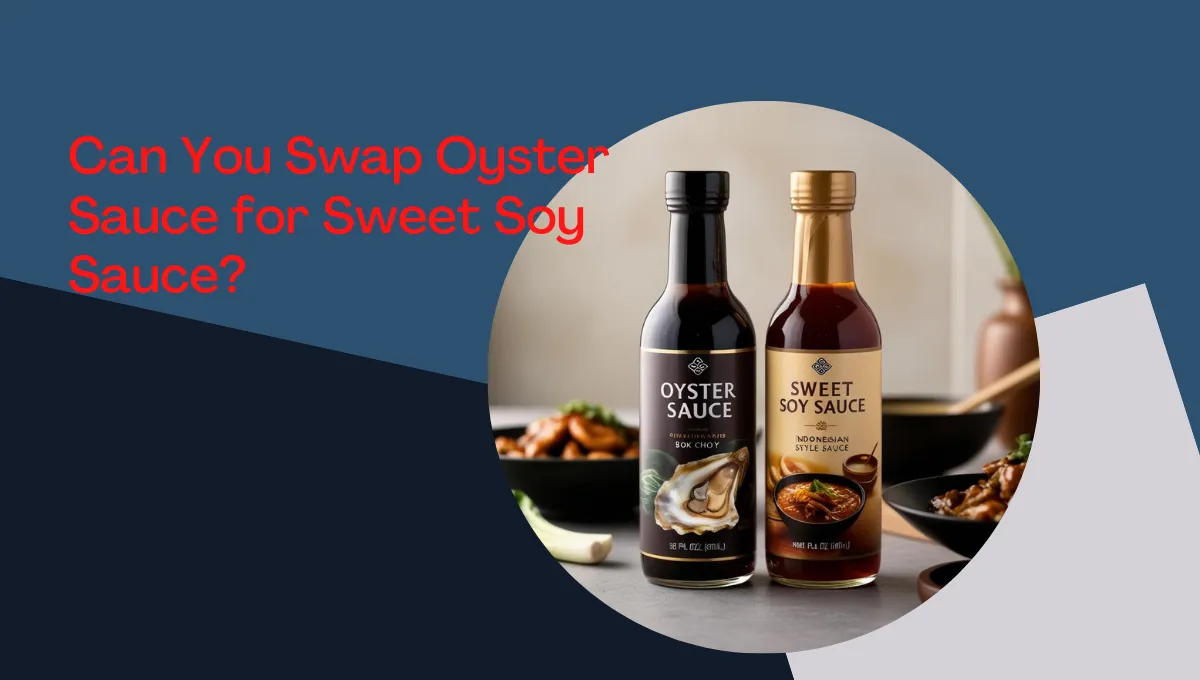Last updated on August 17th, 2025 at 07:22 am
Thai Cuisine & Condiments: Oyster Sauce vs. Sweet Soy Sauce – Which One to Use & When
What is Oyster Sauce?
Oyster sauce is a thick, dark brown sauce made from oyster extracts, sugar, salt, and cornstarch. It has a rich umami flavor with a slightly sweet undertone and is often used in Chinese, Thai, and Vietnamese cooking.
What is Sweet Soy Sauce?
Sweet soy sauce, or kecap manis, is a thick, sweetened soy sauce originating from Indonesia. It adds palm sugar or molasses to traditional soy sauce, creating a syrupy, flavorful condiment.
Oyster Sauce Taste Profile:
- Savory and umami-rich
- Slightly sweet with a deep, caramelized flavor
- Thick and glossy texture
Best Uses for Oyster Sauce:
- Stir-fries are a key ingredient in beef, broccoli, and Thai basil stir-fry.
- Marinades: Adds depth when mixed with soy sauce, garlic, and sesame oil for meats and tofu.
- Glazes: Perfect for grilled meats, seafood, or vegetables.
- Soups & Broths: Enhances the umami factor in pho, hot pot, and noodle soups.
Oyster Sauce Substitutes:
- Vegetarian Oyster Sauce: Made from mushrooms, offering a similar umami-rich profile.
- Soy Sauce + Hoisin Sauce: A combination that mimics the sweetness and depth of oyster sauce.
- Fish Sauce + Brown Sugar: Brings a similar salty-sweet balance but with a more pungent aroma.
Sweet Soy Sauce Taste Profile:
- Sweet and slightly salty
- Caramel-like depth with mild umami
- Thick and syrupy texture
Best Uses for Sweet Soy Sauce:
- Pad Thai Sauce: A crucial ingredient for creating the signature sweet-savory balance in pad Thai.
- Rice & Noodle Dishes: Enhances fried rice, lo mein, and stir-fried noodles.
- Dipping Sauce: Mixed with chili and garlic for a delicious accompaniment to dumplings or spring rolls.
- Marinades & Glazes: Adds a caramelized glaze to grilled meats and tofu.
Sweet Soy Sauce Substitutes:
- Regular Soy Sauce + Brown Sugar: Mimics the sweet and salty balance.
- Hoisin Sauce: Offers sweetness with a hint of spice.
- Maple Syrup + Soy Sauce: An excellent alternative for a deep, natural sweetness.
Which One to Use & When?
Use Oyster Sauce When: You want deep umami flavors, richness, and a slightly salty profile (best for stir-fries and meat-based dishes).
Use Sweet Soy Sauce & When: This sauce needs a caramelized sweetness, a thicker texture, and a slightly salty-sweet balance (best for pad Thai, marinades, and glazes).
Common Questions About Thai Cuisine & Condiments: Oyster Sauce & Sweet Soy Sauce
Can I use sweet soy sauce instead of oyster sauce? – No, sweet soy sauce is much sweeter and lacks the deep umami of oyster sauce.
Is oyster sauce gluten-free? – Some brands contain wheat, but gluten-free versions are available.
What can I use instead of sweet soy sauce in Pad Thai? – A soy sauce and brown sugar mix can work as a substitute.
Oyster Sauce vs. Sweet Soy Sauce: Which is Best for Stir-Fries? Master the art of stir-frying with the right Asian sauces! Find out how oyster sauce and sweet soy sauce impact flavor and texture!
Sweet & Sour Sauce: The Perfect Balance of Tangy & Sweet!
Thai Cuisine & Condiments – Sweet and sour sauce is one of the most versatile and beloved condiments in Asian cuisine. It is known for its perfect balance of tangy and sweet flavors. Whether used as a dipping sauce, glaze, or stir-fry ingredient, it enhances dishes with its signature bright and bold taste.
Taste Profile:
Tangy from vinegar or citrus juice
Sweet from sugar, honey, or fruit juice
Slightly savory with umami depth
Best Uses for Sweet & Sour Sauce:
Dipping Sauce: Perfect for egg rolls, spring rolls, dumplings, and fried wontons.
Glazes: Brushed onto meats like pork, chicken, or tofu for a glossy, flavorful coating.
Stir-Fry Sauce: Mixed with vegetables, pineapple, and protein for a delicious sweet and sour stir-fry.
Marinades: Adds a sweet and tangy depth to grilled dishes.
Sweet & Sour Sauce Variations:
Chinese Sweet & Sour Sauce: Made with vinegar, sugar, ketchup, and soy sauce.
Thai Sweet & Sour Sauce: Often includes fish sauce or tamarind for a deeper, richer taste.
Pineapple Sweet & Sour Sauce: Pineapple juice is used for extra fruitiness.
Sweet & Sour Sauce Substitutes:
BBQ Sauce + Vinegar: Adds a smoky, tangy sweetness.
Honey + Lemon Juice + Soy Sauce: Mimics the balance of sweetness and acidity.
Teriyaki Sauce + Rice Vinegar: A sweeter alternative with umami depth.
Common Questions About Sweet & Sour Sauce
Can I use sweet soy sauce instead of sweet and sour sauce? No, as sweet soy sauce lacks the tangy acidity.
Is sweet and sour sauce vegan? Yes, most recipes are plant-based, but check labels for non-vegan additives.
What’s the difference between Thai and Chinese sweet & sour sauce? – Thai versions often include tamarind or fish sauce for a richer depth, while Chinese versions use ketchup and sugar.
Final Thoughts
Whether choosing between oyster sauce vs. sweet soy sauce for your next stir-fry or making the perfect sweet and sour sauce, understanding these essential Thai condiments will help you achieve restaurant-quality flavors at home. Experiment with different sauces to find your ideal match!
Ah, the choice between oyster sauce and sweet soy sauce! Both are fantastic condiments that can add flavor to your dishes.
With its rich, savory, and slightly sweet flavor, oyster sauce is great for stir-fries, marinades, and glazes. It’s a staple in many Asian cuisines, mainly Chinese.
On the other hand, sweet soy sauce, also known as kecap manis, is a thick, syrupy sauce sweetened with palm sugar. It’s commonly used in Indonesian cooking and is perfect for adding a sweet, caramel-like flavor to dishes.
It depends on the flavor profile you’re aiming for. If you want something more savory and umami, go for oyster sauce. Sweet soy sauce is your best bet if you’re after something sweeter and thicker.
The Secret to Perfect Thai Cuisine & Condiments: Oyster Sauce vs. Sweet Soy?
🥢 Enhance your Asian cooking essentials by knowing when to use oyster sauce instead of sweet soy sauce in popular Thai and Chinese recipes!
Thai Cuisine & Condiments: Oyster Sauce or Sweet Soy? Are They Interchangeable?
Are you trying to pick the right Asian sauces? Here’s how sweet soy sauce and oyster sauce compare, and when to substitute one for the other!






